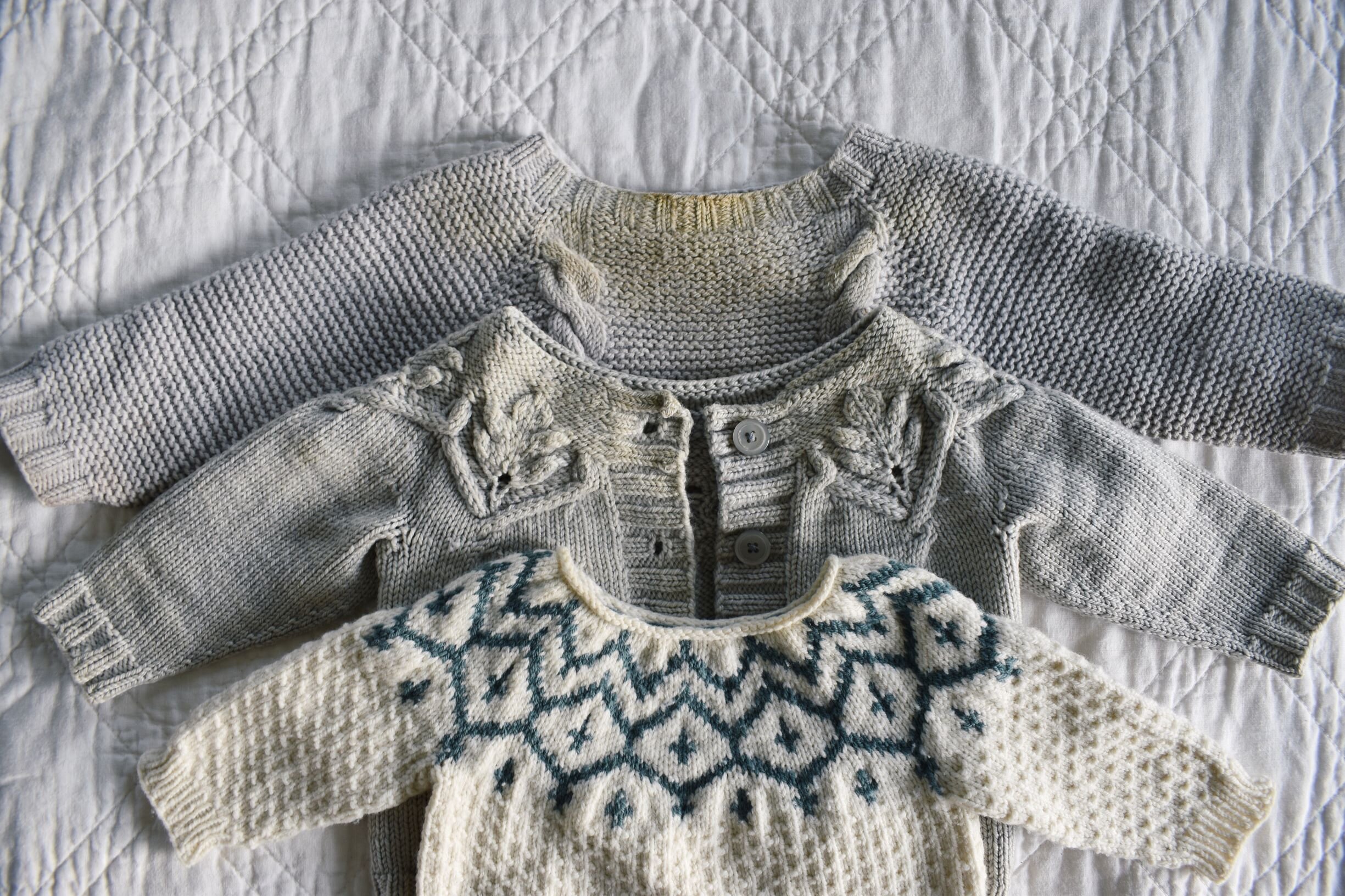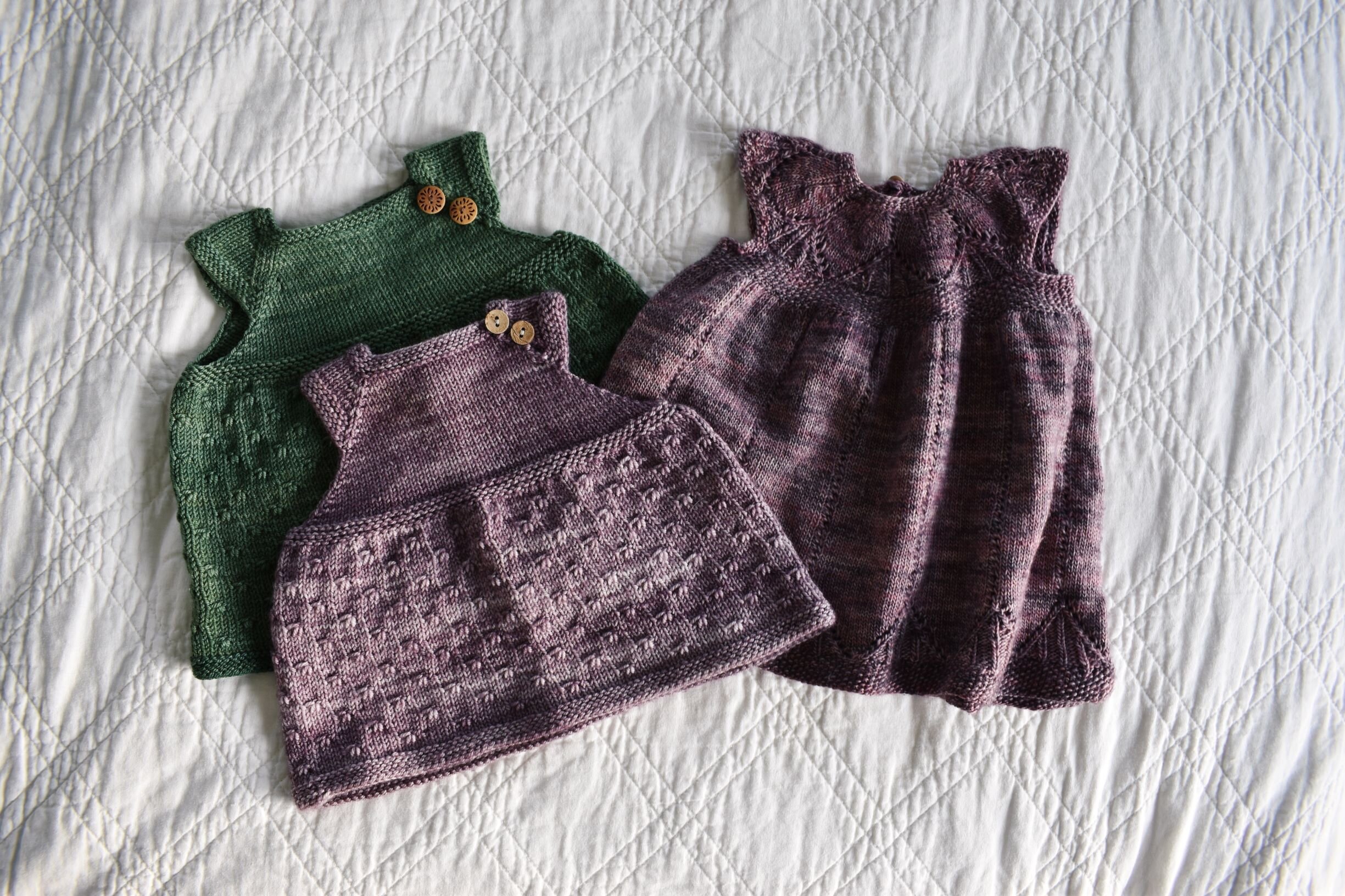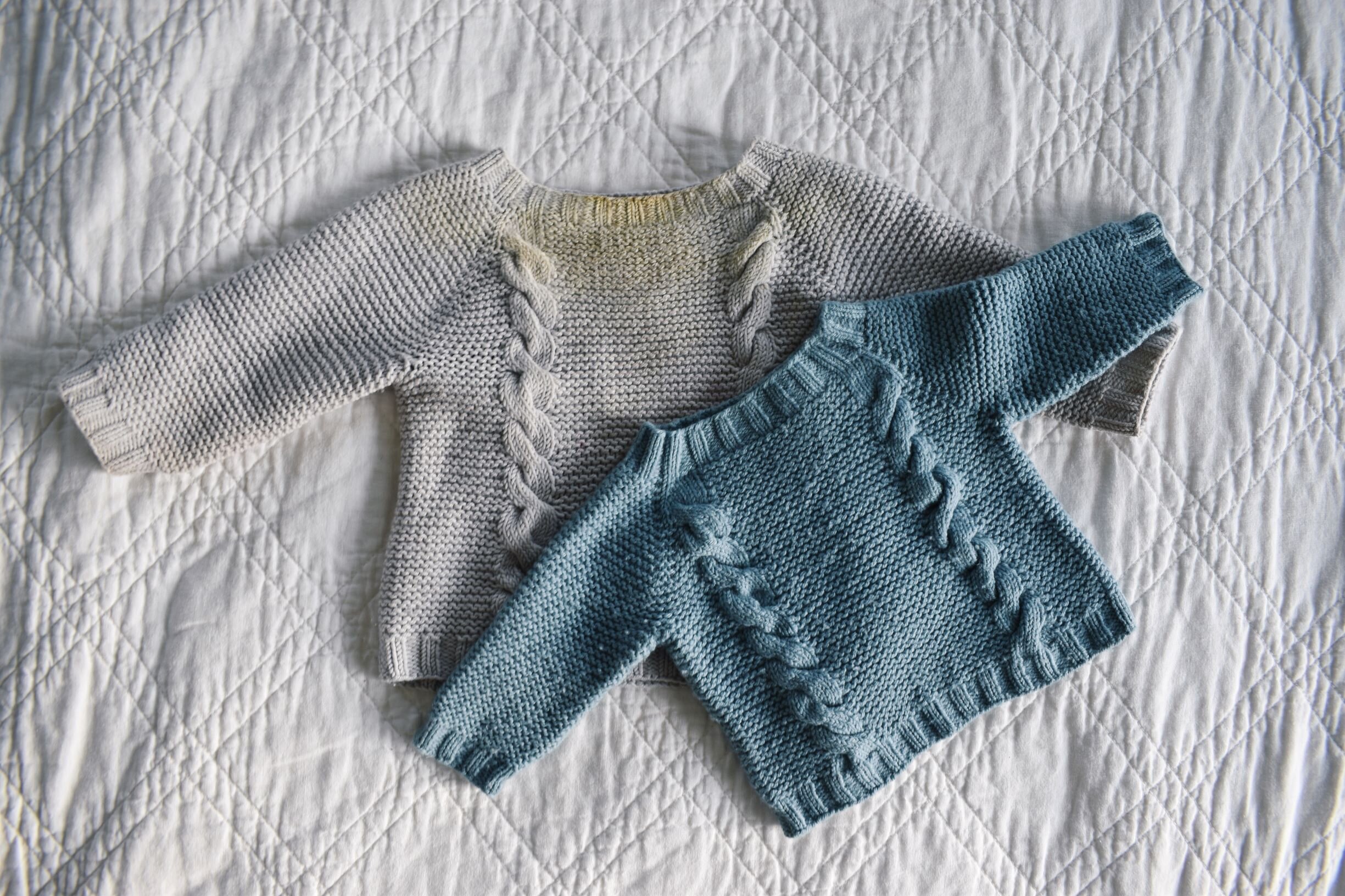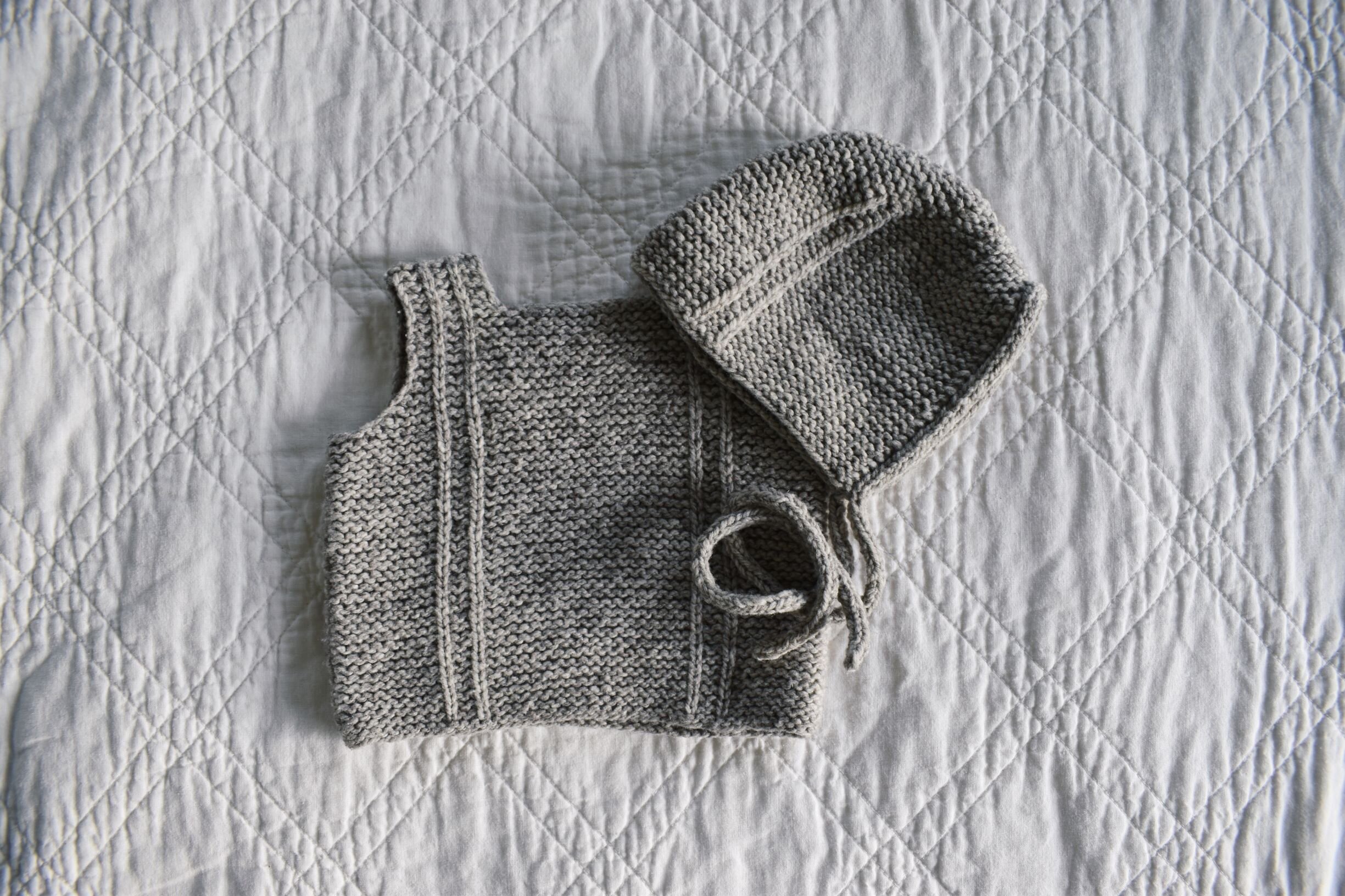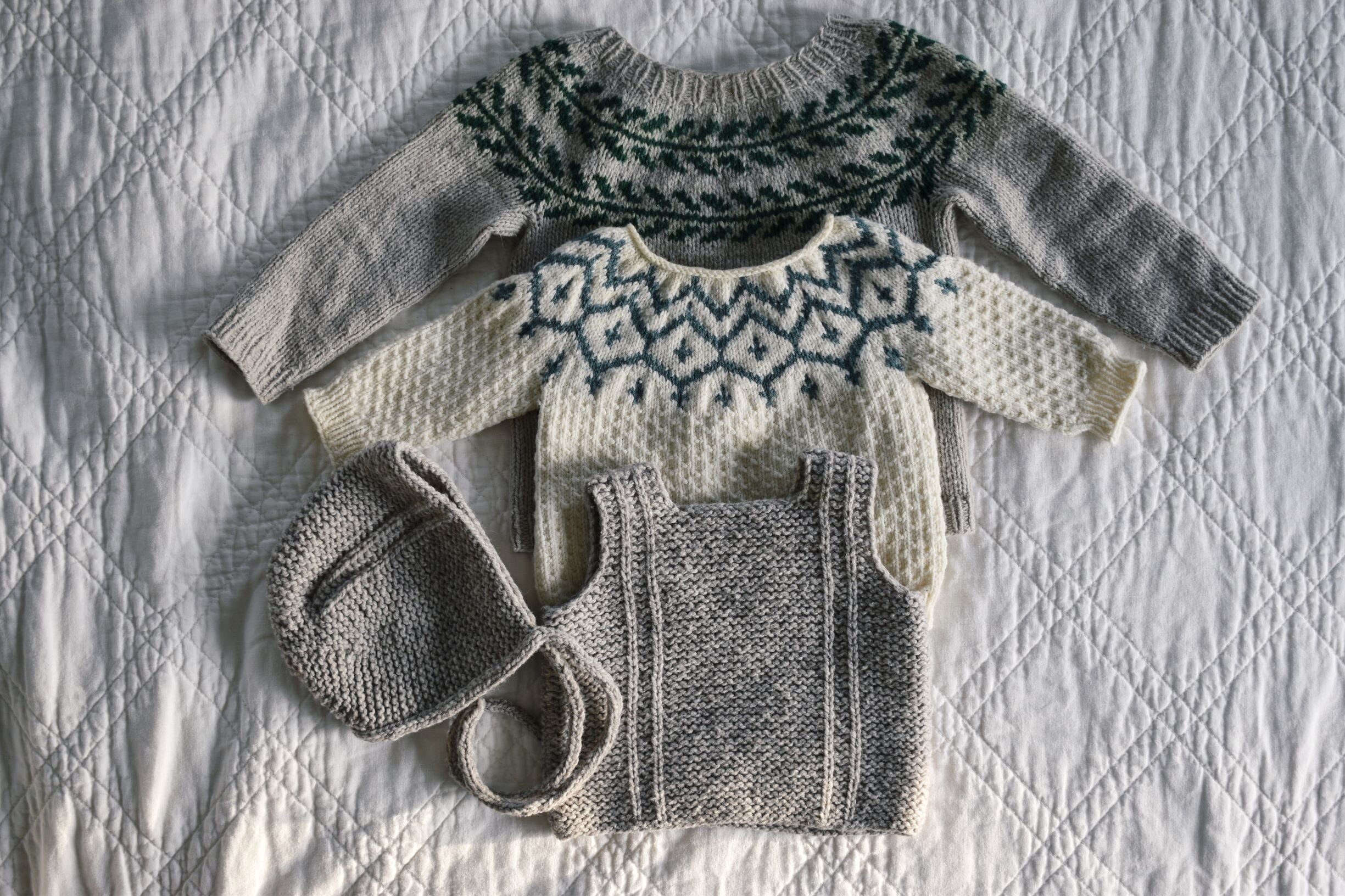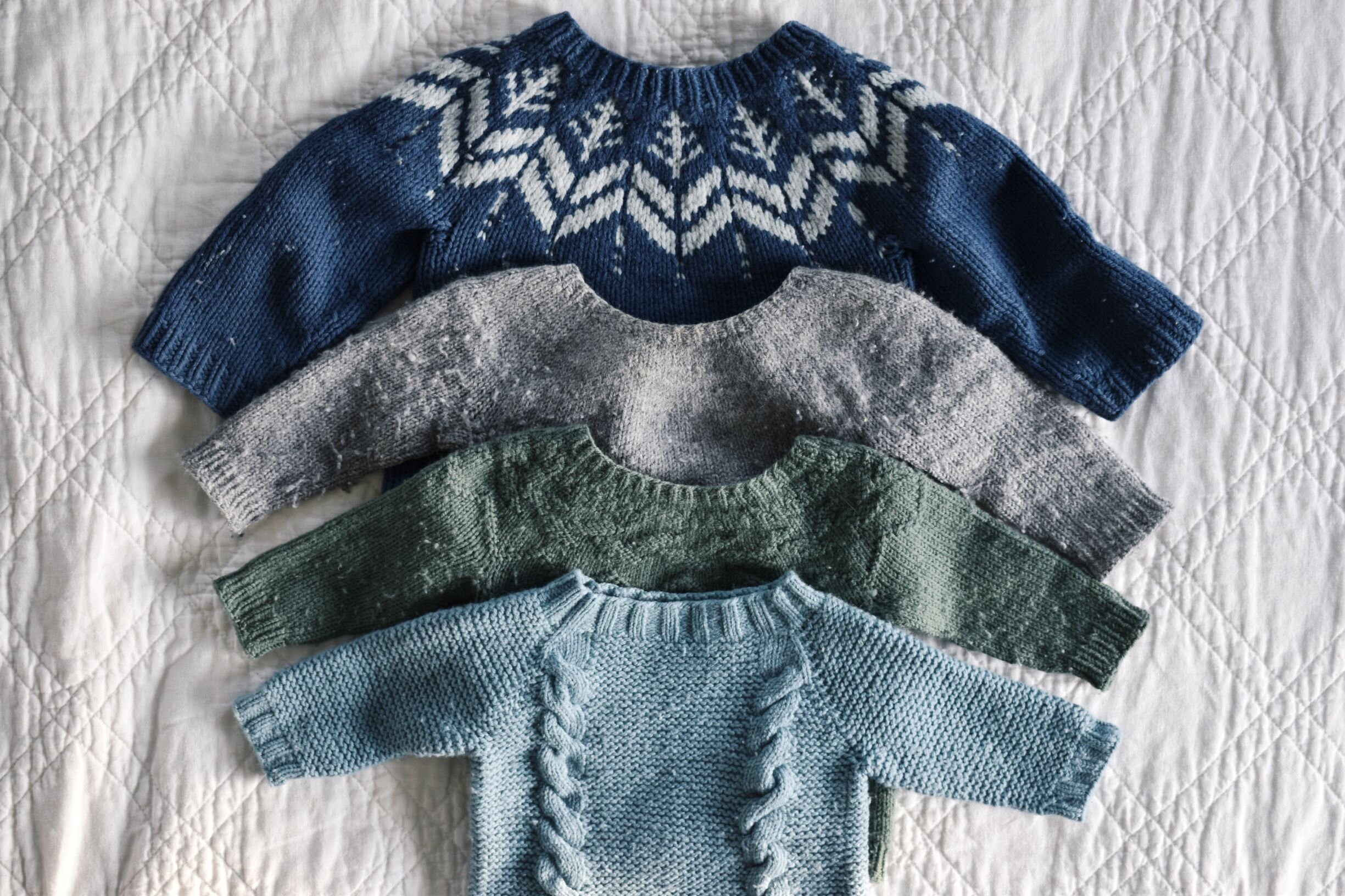Yarn advice for baby sweaters
A giant pile of baby sweaters I have knit and dressed my children in.
One of the most difficult yarn choices a knitter can make is picking a yarn for a baby knit. Superwash is generally considered the go-to yarn, but is it really the best? I’ve being knitting for little ones and dressing them in handknits since 2013, and I’ve learned a lot over the years. In this blogpost I’ll share my opinions with you all and show you all my well-worn little sweaters so you can make an informed decision.
There are two major factors I consider when choosing a yarn for a baby knit. First of all, it cannot be even a tiny bit prickly. Babies are often fussy so there is no need to give them another reason to be unhappy. Second, I want it to wear well. I love it when I tuck away a little sweater, and it still looks as good as the day I completed it. Many of my sweaters have been worn by all of my children, and it is wonderful when the younger siblings get a gorgeous collection of hand-me-downs that don’t shows signs of being well-loved.
Most people default to recommending superwash yarns for babies, but I don’t. In fact, I strongly recommend using 100% non-superwash wool. Superwash has a reputation for being easy to care for, but it stains like crazy. Baby drool alone will stain it. Compare these three little sweaters in the picture below. All of them made from a lighter colored yarn, and all worn by babies. The bottom two have stains around the neck, but the top one has absolutely no discoloration in spite of all the spit up and drool it soaked up while being worn. The bottom two are made from superwash, and the top one is made from non-superwash wool.
Bottom to top: Silver Creek, Little Oaks (a beloved gift from a knitting cousin), and Snowfall.
If you do want to use superwash, choose a darker color. These three little dresses below have been made from superwash yarns as well, but the stains don’t show up on them because their color hides stains very nicely.
Two Wildflower Tunics on the left and a Clara dress on the right. All from my Madelinetosh phase.
Staining is not the only downside to superwash yarns. Compare these two sweaters in the picture below. Same pattern and both worn by babies. Now look closely at the fabric. The garter stitch and the cables on the blue one remain plump and squishy, while the gray one looks a bit deflated and flat. The gray one is superwash, and has started to stretch out.
Two Silver Creeks I knit for my boys.
Superwash grows like crazy. It may not seem like a bad thing to have a sweater that grows right along with the baby, but the fabric ends up distorted, and just doesn’t look good as the yarn stretches out. I had a little cardigan fit my second daughter from the time she was 18 months until she was 3 years old. That may seem delightful at first glance, but by the time I took it out of her wardrobe, it was ugly, lopsided, and so stretched out you could see right through it. It definitely wouldn’t be an heirloom piece that you could hand down to younger siblings or tuck away somewhere to show off to future generations. It was only fit for the trash.
To sum up, superwash stains and stretches out, and for these two reasons I do not recommend using it. However, I do think it does have its moment. If you are knitting a baby gift and the parents are not interested in the extra care non-superwash wool requires, then go for superwash. Just pick a darker color so that it will not show stains.
I’ve never knit with cotton yarn. I know that you can machine wash it so it is a nice option for if you want to avoid superwash but still be able to toss it in the washing machine. However, I cannot say any more about it because I’ve never used it. If you have used it, feel free to share your opinion in the comments! I would love to learn more about it.
Alpaca and alpaca blends have a reputation for being soft and cozy, but that gorgeous halo does not play well with babies. This little green vest below is made of a wool and alpaca blend and was very lightly worn by a few newborns. It pills instantaneously, and the alpaca fibers tend to get in the baby’s mouth. For these reasons, I choose not to use any yarn with alpaca in it for babies.
The Pebble vest with the side buttons eliminated. Taught me that buttons on the shoulders are not a great idea for baby knits.
So what yarns do I recommend? 100% non-superwash wools are my absolute favorite. They knit up nicely, are cozy and warm, and hold up well to being worn by little ones. Yes, they require handwashing and a bit more maintenance, but I think the few minutes of extra work are worth all the benefits. I’ll write a blogpost showing you how I take care of my wool baby knits so keep an eye on my blog for that one.
When choosing a wool yarn, it is often a trade off between softness and durability. The softer the yarn, the quicker it will show wear and the more it will pill. More rustic yarns can be worn hard and still look pristine, but you end up taking the risk of itchiness or prickliness. Personally, I think a more rustic yarn can work just fine for a baby as long as it doesn’t have any prickle to it.
You may be scratching your head now wondering how a rustic yarn can not be prickly, but it is possible. Take Barrett Wool Co Wisconsin Woolen Spun worsted weight for example. I used this yarn to knit the Going Home Set (vest and bonnet below). It is a rustic yarn, but doesn’t have even a hint of prickle to it. If you hold it against your skin, it feels a bit rough, but there aren’t any little hard fibers sticking out of the yarn and poking you. The fingering weight version of this base is prickly though so I wouldn’t recommend using it for babies.
The Going Home Vest and Bonnet. Light, woolly, and oh so cozy. Looks amazing even after three months of constant wear.
The rustic nature of this yarn means it holds up beautifully. Aiden wore his Going Home Set constantly for about three months, and it still looks brand new. I also used it to knit all my Ruska sweaters. It is a gorgeous yarn, and I love it.
Aiden got a whole fleet of sweaters made in Barrett Wool Co. Fletching is knit in Woolens, Snowfall in Home fingering weight, and The Going Home Set in Wisconsin Wool Spun worsted weight.
Softer yarns are also a wonderful choice even if they will show wear more quickly. I often use Quince & Co yarns because they are so reliably so soft. They aren’t so soft that the sweaters end up with holes in them, but you will want to have a pill remover handy. After the little one outgrows the sweater, you will be able to tell that it has been previously loved. Even so, many of my favorite sweaters are knit with Quince & Co yarns. All of these sweaters below have been made using Quince & Co yarns. You can see that some of them need to have a date with my pill remover, but they are wonderfully soft and hold up well to wear.
Bottom to top: Little Treeline, Woodsmoke, Sweet Sage, and Silver Creek.
Hopefully by now I’ve convinced you to choose non-superwash yarns for babies. I made the decision several years ago to stop using superwash, and I’ve never once regretted it. Non-superwash wool yarns just function so much better. The care is not too terribly fussy either. It just requires a few minutes of handwashing, which I am more than happy to do.
The yarns I have named here are not an exhaustive list of yarns suitable for babies and children. These are just the ones that I have used, liked, and can recommend. I am sure that there are many other wool yarns that work wonderfully for children. If you have any recommendations, please let us know in the comments!
If you would like to see all the baby patterns I have designed, you can find them here.
Pin for later:


